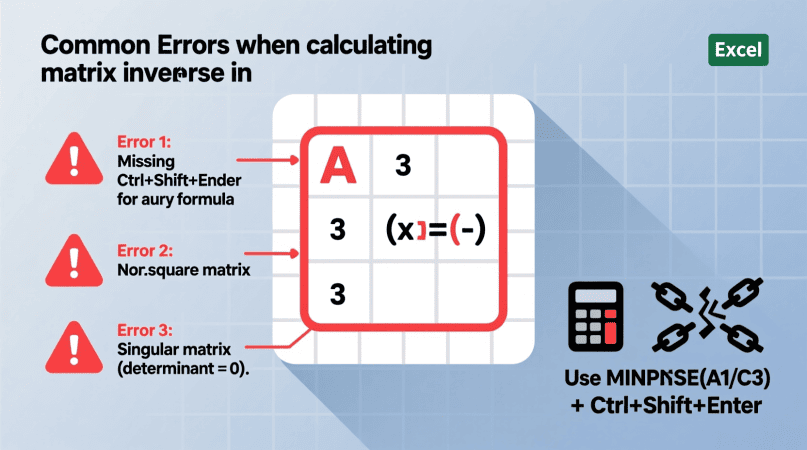
Excel is a powerful tool for basic matrix operations, including matrix inversion using the MINVERSE function.
However, users often encounter confusing results — #VALUE!, #NUM!, or even blank arrays.
This guide explains the most common errors when calculating a matrix inverse in Excel, why they occur, and how to fix them step by step.
Quick Refresher: How Matrix Inversion Works
The inverse of a matrix (A^{-1}) is defined such that: A×A−1=I
where (I) is the identity matrix.
Excel’s built-in function MINVERSE(array) can compute (A^{-1}), but only if the matrix:
- is square, and
- has a non-zero determinant.
You can double-check your manual inverses using our Inverse Matrix Calculator, which handles matrices of any size.
Non-Square Matrices (#VALUE! Error)
Problem:
If your array isn’t square (e.g., 3×2 or 2×3), Excel will return a #VALUE! error.
Why It Happens:
Only square matrices (like 2×2, 3×3, 4×4) can have inverses.
Rectangular matrices don’t satisfy the conditions for invertibility.
Fix:
- Ensure your input array has equal rows and columns.
- If your matrix isn’t square, use a pseudoinverse instead — available in our Pseudo Inverse Calculator.
Learn more: Matrix Inverse vs Pseudoinverse
Singular Matrix (#NUM! Error)
Problem:
Excel displays a #NUM! error when the matrix determinant equals zero.
Why It Happens:
A matrix is singular (non-invertible) if one row or column is a multiple of another — meaning (\det(A) = 0).
This makes inversion mathematically impossible.
Fix:
- Check the determinant using Excel’s
MDETERM(array)function. - If
MDETERM= 0, the matrix has no inverse. - Modify your matrix or use a pseudoinverse to proceed.
You can confirm this using the Determinant of a Matrix Guide or the Why My Matrix Has No Inverse article.
Not Entering as an Array Formula
Problem:
The inverse doesn’t display properly — only one cell shows, or you see incomplete results.
Why It Happens:
In Excel, MINVERSE outputs a range of values equal in size to your original matrix.
If you don’t select that full output range, Excel won’t fill the inverse correctly.
Fix:
- Highlight a cell range the same size as your matrix (e.g., 3×3).
- Type the formula
=MINVERSE(A1:C3). - Press Ctrl + Shift + Enter (or just Enter in newer Excel versions).
This ensures Excel treats it as an array function and returns the full inverse matrix.
Incorrect Cell Range Selection
Problem:
The wrong range is selected before applying MINVERSE, leading to incomplete or misplaced results.
Fix:
- Always match your selection range with the input size.
- Example: for a 3×3 matrix in
A1:C3, selectE1:G3before applying=MINVERSE(A1:C3).
- Example: for a 3×3 matrix in
- Press Ctrl + Shift + Enter to apply correctly.
Tip:
To avoid confusion, use consistent matrix dimensions and naming (e.g., Matrix_A, Inverse_A).
Data Entry Errors or Hidden Decimals
Problem:
Your matrix seems invertible but returns incorrect or inconsistent results.
Why It Happens:
Hidden decimal places or rounding errors can make the determinant effectively zero.
Excel’s limited precision can cause near-singular matrices to behave as if they’re non-invertible.
Fix:
- Increase precision:
File → Options → Advanced → Set precision as displayed. - Avoid rounding early in your dataset.
- Test invertibility using a symbolic calculator like the Symbolic Matrix Inverse Calculator.
Using MINVERSE on Large Matrices
Problem:
For very large matrices (e.g., 6×6 or more), Excel may slow down, crash, or give inconsistent rounding.
Why It Happens:
Excel isn’t optimized for large-scale numeric inversion — rounding and floating-point limits reduce accuracy.
Fix:
- Use specialized tools like MATLAB, NumPy, or online solvers.
- For quick checks, try the 6×6 Matrix Inverse Calculator.
You can also check your steps manually with our Gauss–Jordan Method Guide.
Forgetting to Multiply by the Result
Problem:
After getting the inverse, users forget that the solution to (A X = B) requires multiplication: [ X=A−1B ]
Fix:
Use Excel’s MMULT function:
=MMULT(MINVERSE(A1:C3), D1:D3)
This gives you the vector of unknowns (X).
For a full tutorial on solving systems this way, see Linear Equation Solving Guide.
Forgetting Modular Arithmetic in Cryptography
Problem:
When using matrix inversion in cryptographic applications (like Hill cipher), users forget to apply modular arithmetic.
Fix:
Excel doesn’t handle modular inverses automatically.
For cryptography or mod-based systems, use specialized tools or the Casio Matrix Inverse Calculator.
Misinterpreting the Results
Problem:
Users often misread the returned inverse, thinking Excel has modified their data.
Explanation:MINVERSE doesn’t overwrite your original matrix — it simply produces a new matrix in the selected range.
If your results look unexpected, double-check placement or formatting.
Forgetting Validation
Problem:
Even when Excel computes an inverse, users fail to verify it.
Fix:
After computing the inverse, multiply the original and inverted matrices using:
=MMULT(A1:C3, E1:G3)
If the result is an identity matrix, your inverse is correct.
You can also validate with the Inverse Matrix Calculator for guaranteed accuracy.
Excel Functions Summary
| Function | Purpose | Example |
|---|---|---|
MDETERM(array) | Computes determinant | =MDETERM(A1:C3) |
MINVERSE(array) | Finds matrix inverse | =MINVERSE(A1:C3) |
MMULT(array1,array2) | Multiplies matrices | =MMULT(A1:C3, D1:D3) |
Pro Tips
Always check determinant before inverting.
Use Ctrl + Shift + Enter for array formulas (in legacy Excel).
Increase precision for accurate results.
Verify by multiplying with MMULT.
Use specialized calculators for large or symbolic matrices.
For step-by-step examples, see How to Calculate the Inverse of a Matrix in Excel.
Frequently Asked Questions
1. Why does Excel return #NUM! when using MINVERSE?
Because your matrix is singular — its determinant is zero.
2. How do I fix #VALUE! errors in MINVERSE?
Ensure the matrix is square and you’ve entered the formula as an array.
3. Can I find inverses for non-square matrices in Excel?
No, but you can use pseudoinverses — try our Pseudo Inverse Calculator.
4. How can I check if my matrix has an inverse?
Use MDETERM. If the result is zero, the matrix has no inverse.
5. What’s the easiest way to test my result?
Multiply (A \times A^{-1}). If you get the identity matrix, your inverse is correct.
John H. Cleveland is the creator of Inversematrixcalculator.com, a trusted resource dedicated to providing accurate and easy-to-use matrix calculation tools. With a strong background in mathematics and a passion for simplifying complex concepts, John focuses on delivering clear, reliable solutions for students, educators, and professionals. His goal is to help users save time and confidently solve matrix problems with precision.
